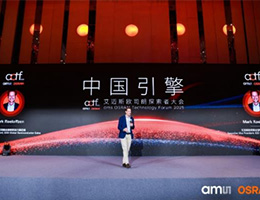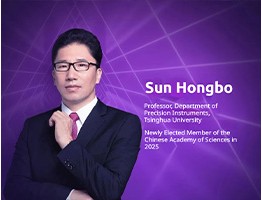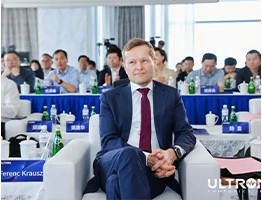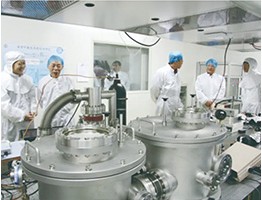Zheng Wanhua’s Team (Semiconductor Inst.): New Progress in Self-Organized Topological Lasers
source:Third Generation Semiconductor
keywords:
Time:2025-10-14
Source: Third Generation Semiconductor Industry 9th Oct 2025
Latest achievements
Self-organization refers to the collective resonance phenomenon where individual elements spontaneously arrange themselves into ordered patterns through internal interactions. However, the chaotic multimode synchronization in traditional semiconductor laser cavities limits their performance in practical applications. Topological photonics, which originated from the theory of topological states of matter in condensed matter physics, provides a new paradigm for constructing photonic states with robustness, unidirectionality, and strong localization by using "topological invariants" to describe the band structure of photonic crystals.

Recently, the team led by Academician Zheng Wanhua from the Institute of Semiconductors, Chinese Academy of Sciences (CAS) published an innovative achievement in Laser & Photonics Reviews. The team successfully observed the self-organized lasing phenomenon based on delocalized topological boundary states, realized large-scale highly coherent laser emission, and accurately resolved the core contradiction in traditional lasers—the mutual constraint between high power and high coherence. Traditional devices, limited by physical mechanisms, often require trade-offs between the two; however, relying on the delocalized topological boundary states and the self-organized synchronization mechanism assisted by non-Hermitian modulation, this study not only retains the high coherence advantages endowed by topological protection and self-organization, but also expands energy distribution through delocalization, ultimately forming an innovative technical solution for the synergistic optimization of "power-coherence".

Schematic diagram of laser output and basic principles
Starting from the classic one-dimensional topological Su-Schrieffer-Heeger (SSH) model, the research team utilized the chiral symmetry protection property of the structure to regulate the unit coupling strength in the SSH lattice, achieving the delocalized distribution of topological edge states in real space. Meanwhile, by leveraging the non-Hermitian modulation based on the patterned electrode structure, the delocalized topological edge states can maintain a dominant position in the disordered background, presenting a unique self-organized pattern. Compared with photonic crystal lasers of the same scale, this topological laser exhibits higher spatial coherence, which enables it to demonstrate a lower threshold, more stable output spatial mode, and higher speckle contrast. Additionally, it further expands the spatial distribution scale of the topological edge states and introduces a phase-shifting coupler to enhance the output optical power density.

This solution not only enriches the technical pathways for topological lasers, but also aligns with the development trend of topological photonics penetrating into integrated photonic chips and high-performance optical emission devices, further advancing the technological implementation of topological physics in the photonics field.
Entitled "Self-organized lasing of delocalized state enabled by non-Hermitian manipulation and chiral symmetry," this achievement was published in Laser & Photonics Reviews (DOI: 10.1002/lpor.202501772). Chen Jingxuan (postdoctoral fellow) and Tang Chenyan (Ph.D. candidate) from the Institute of Semiconductors, Chinese Academy of Sciences, are the co-first authors; Young Researcher Wang Mingjin and Academician Zheng Wanhua are the co-corresponding authors.
This work was supported by programs including the National Natural Science Foundation of China (NSFC) and the Beijing Science and Technology New Star Program.
Article link:
https://doi.org/10.1002/lpor.202501772
 9th Secret Light Awards Launch: Million-Yuan Fund + National Award Recommendation
9th Secret Light Awards Launch: Million-Yuan Fund + National Award Recommendation Top Enterprises Gather: 1st Laser & Additive Manufacturing Innovation Conference Wraps Up
Top Enterprises Gather: 1st Laser & Additive Manufacturing Innovation Conference Wraps Up 2025 ams OSRAM Explorer Conference: "China Engine" Drives Future Innovation
2025 ams OSRAM Explorer Conference: "China Engine" Drives Future Innovation Tsinghua's Sun Hongbo, SLA Review Expert, Becomes CAS Academician
Tsinghua's Sun Hongbo, SLA Review Expert, Becomes CAS Academician 4th Collaboration! What Brought the Global Laser Academic Guru to Chinese Univs & Leading Firms?
4th Collaboration! What Brought the Global Laser Academic Guru to Chinese Univs & Leading Firms?
 Scanner Optics: Galvanometer Tech Leader
Scanner Optics: Galvanometer Tech Leader The "Light Chasers" in the Deep Ultraviolet World
The "Light Chasers" in the Deep Ultraviolet World Shi Lei (Hipa Tech): Focus on Domestic Substitution, Future Layout in High-End Laser Micromachining
Shi Lei (Hipa Tech): Focus on Domestic Substitution, Future Layout in High-End Laser Micromachining Optizone Technology: 17 Years Devoted to Optics – High-Power Optics Mass-Production Pioneer
Optizone Technology: 17 Years Devoted to Optics – High-Power Optics Mass-Production Pioneer Zhuojie Laser: Breaking barriers via tech breakthroughs, aiming to lead high-end light sources
more>>
Zhuojie Laser: Breaking barriers via tech breakthroughs, aiming to lead high-end light sources
more>>










